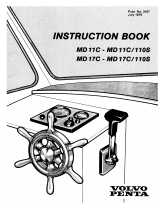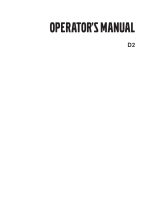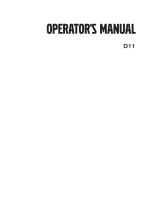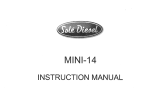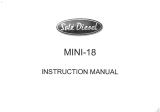Page is loading ...



FOREWORD
Before you start running your new Volvo Penta marine engine, you would be
advised to read through this instruction book carefully. It contains all the
information you need to run and service your engine in the best possible way.
Volvo Penta has built up an extensive service organization with service shops and
specially trained personnel at your service.
Always contact your local Volvo Penta representative for advice and when in need
ot service and parts.
We are convinced that the demands on good running economy and top
performance, which you have every right to expect of a quality product, will be met
and that your engine will serve you faithfully on many pleasant cruises.
WARRANTY
A warranty certificate is supplied with each engine. It contains the warranty
conditions for the engine and should be studied carefully.
Also included is a report card which is to be completed by the dealer or boat
seller. If our warranty is to apply, however, it is an absolute condition that the
measures given in the “Check and Service Scheme” are carried out and that your
engine and equipment are looked after according to the instructions in this
manual. When in doubt, always get in touch with an authorized Volvo Penta
dealer.
In all correspondence with your dealer and when ordering parts, state the type
designation and serial number of the engine and reverse gear (see starboard side
of engine).


1
Presentation
2
General Information
3 - 4
Running Instructions
5
-
6
Starting the engine
Running instructions
Shutdown procedure
5
6
6
Technical Description
7 - 9
Checks and Service Scheme
10
Checks and Service
11
-
17
Check daily before starting
Check every 14 days
Service every 50 hours of operation
Service every 100 hours of operation
Laying-up and launching
11
11 - 12
12 - 13
13 - 19
20 - 23
Fault Tracing Scheme
24
Technical Data
25 - 26
Wiring Diagram
27
Engine Component Guide
28
Index, alphabetical order
29
CONTENTS

2
INSTRUMENT PANEL
1. Switch, optional equipment
2. Warning lamp, “Excess temp.”
3. Place for instrument (ø 52 mm opt. equipment)
4. Warning lamp, “No oil pressure”
5. Switch, optional equipment
6. Warning lamp, “No battery charging”
7. Siren, “No oil pressure, excess temp.”
8. Key switch
CONTROL SYSTEM
Volvo Penta Single Control System
For side mounting
1. Control lever
2. Disengaging button
Push in the button when the control lever is in neutral
and move the lever a bit forwards. Release button.
The lever is now used only for engine speed control.
To use the lever for both engine speed control and
gear-changing, push in the button and pull back the
lever to neutral.
N = Neutral
F = Control lever in position for running “Forward”
R = Control lever in position for running “Reverse”
T = Engine speed control
PRESENTATION

3
Important information on the function of your engine:
FUEL
Use diesel fuel oil of quality “Autodiesel”. Poorer fuel quality
can cause interruptions in operation.
LUBRICATING
OIL
Use only oil with quality CD (DS) according to the API system.
Volvo Penta oil for diesel engines can be used with
advantage since it meets these quality demands. See under
“Technical Data” concerning the viscosity.
RUNNING-IN
A new marine engine must be run-in with due care during the
first 20 hours of operation. If full output is taken out during this
time, it should only be done for short periods.
Oil change. Change the engine lubricating oil and the oil filter
after the engine has been run for 20 hours. See further under
“Checks and Service”.
ENGINE SPEED Max. speed: 41.7 rev/sec (2500 rev/mm).
For choice of correct propeller, refer to the Volvo Penta propeller diagram. Check the
engine speed with normal load in the boat. In order to utilize the maximum performance
of the engine, an engine speed as high as possible should be chosen but not, however,
greater than 41.7 rev/sec (2500 rev/mm).
NOTE. When the boat has been in the water for some time, the speed and max. rev/mm
can drop due to marine growth on the hull. Prevent marine growth by painting the bottom
of the boat with anti-fouling paint. See under “Measures taken when launching”.
GENERAL INFORMATION

4
SAFETY EQUIPMENT
Irrespective of whether the boat is being used for long cruises or short bathing trips, the
boat should be equipped with the safety equipment listed below. It can, of course, be
supplemented further according to personal tastes. Investigate at regular intervals to
ensure that there is safety equipment on board and that it is in working order.
LIFE-JACKETS for all on board.
FIRE EXTINGUISHER, approved, at least one and installed where it is easy to get at.
DISTRESS ROCKETS and matches. Packed watertight.
FIRST-AID BOX
TOOLS suitable for the equipment on board.
ON BOARD KIT containing, e.g. impeller, etc.
ANCHOR with line.
RADAR REFLECTOR
RADIO for listening to, e.g., weather reports.
COMPASS which is deviated.
BOAT HOOK and paddle.
MOORING ROPES
FOG-HORN and whistle.
FLOATING ANCHOR
TORCH
PREPARATIONS BEFORE STARTING
Make sure that:
There is no FUEL LEAKAGE
There is no WATER LEAKAGE from engine and hull
There is no OIL LEAKAGE
There is no SMELL OF LP-GAS in the deep cavities in the boat or elsewhere
The OIL LEVEL is correct
There is enough FUEL for the planned voyage
The proper NAUTICAL CHARTS are on board for the planned voyage
If there are some other persons on board, make sure that some of them is able to
operate the boat.
If there are persons on board who have never been on a boat before, tell them where the
life-jackets are located and where the fire-extinguisher is placed. Also tell them anything
more you think necessary from a safety point of view. Should something unexpected
happen during the voyage, it is very often too late to tell those on board how safety
equipment works.
GENERAL INFORMATION

5
STARTING THE ENGINE
Switch on the main switch. Start the engine room fan (if
fitted) and let it run several minutes before starting the engine.
Open the cock for the cooling water intake.
Disengage the engine speed control from the gear-
changing as follows:
Move the control lever to neutral, push in the red disengaging
button, and move the lever slightly forwards. Release the
button. The lever can now only operate the engine speed.
Check to make sure that the stop control is pushed in.
Turn the key switch one stage to the right. The warning
lamps for battery charging and oil pressure should now go on
and the siren should sound. Push in and turn the key further to
the right to start the engine. Release the key when the engine
starts.
Hand starter. If the engine is started with the starting crank,
the decompression handle on the rocker arm cover should first
be folded up. Fold down this handle for running when the
cranking has got the engine up in speed.
Starting in cold weather is facilitated if the cold-start control
is pulled out. Push it in again after a while.
Check immediately after starting that the warning lamps for
the oil pressure and battery charging are out and that the siren
is quiet. If any of the lamps are on and the siren is
sounding, the engine must be stopped immediately and
an investigation made.
Run the engine warm at rapid idle. Check to make sure that
the cooling water flows out with the exhaust gases.
NOTE. The key switch should always be switched on as
long as the engine is running to ensure that there is
battery charging.
RUNNING INSTRUCTIONS

6
Reduce to idle and check that the engine is running smoothly.
Engage the control lever for gear-changing as follows:
Push in the red disengaging button and pull the lever back to
neutral. Release the button. The control lever can now be
used both for gear-changing and engine speed.
RUNNING
The single lever control has both engine speed and
manoeuvering functions.
F = Forward N = Neutral
R = Reverse T = Engine speed control
To achieve good running economy, the engine should not be
run at max. speed for a longer period.
Make sure that the battery charging warning lamp does not
light when the engine is running The siren will sound and the
respective warning lamp go on if the engine temperature
becomes excessive or the oil pressure too low.
SHUTDOWN PROCEDURE
After shutdown the engine should be allowed to idle for a
couple of minutes or so with the control lever in neutral.
Stop the engine by pulling out the stop control when the
engine is idling. Then turn back the key switch to the initial
position.
Switch off the main switch. NOTE. This switch must never
be switched off until the engine has stopped.
Close the fuel and cooling water cocks if the boat is not going
to be used for some time.
Check for leakage before leaving the beat.
In cold weather and whenever there is risk of icing, the
cooling water should he drained from the engine and reverse
gear. See under “Laying-up and launching”.
RUNNING INSTRUCTIONS

7
The MD5A is a single-cylinder, 4-stroke, marine diesel engine with direct injection and
sea-water cooling.
ENGINE ASSEMBLY
The engine block and cylinder head are made of cast iron. Cylinder angle 45
o
. The
cylinder liner is replaceable. The engine has overhead valves.
LUBRICATING SYSTEM
The lubricating system includes a full-flow oil filter which filters all the oil before it reaches
the lubricating points. A relief valve in the oil pump prevents the oil pressure from
becoming excessive.
ELECTRICAL SYSTEM
The engine has a starter motor and alternator with built-in rectifier. Voltage regulation is
taken care of by a transistorized regulator mounted on the alternator. The alternator
makes it possible to charge two battery circuits independent of each other if a charging
distributor (accessory) is fitted on the alternator.
A main fuse, which can easily be re-connected, is fixed to the engine. It protects the
electrical system from damage in the event of overloading. The wiring diagrams for the
engine and instrument panel are shown on page 27.
TECHNICAL DESCRIPTION

8
FUEL SYSTEM
The fuel system contains a feed pump with pre-filter, fine filter, injection pump and
injector. The feed pump, which is of the diaphragm type, has also a hand priming lever.
Also fitted is a cold-start device with lever for connection of the push-pull control.
COOLING SYSTEM
The engine is sea-water cooled. The cooling system includes a sea-water pump as well
as a water distributor housing with thermostat.
The sea-water pump has an impeller of neoprene rubber driven by the camshaft via a
rubber flange.
The thermostat installed in the water distributor housing regulates the water flow so that
the water always flows through the exhaust manifold and out into the exhaust elbow
irrespective of whether the engine is cold or warm.
TECHNICAL DESCRIPTION

9
REVERSE GEAR
The Volvo Penta reverse gear, type Mono Shift (MSB) has a reduction ratio of 1.91:1.
The reduction gear is integrally built with the reverse gear. Power transmission from the
engine to the reverse gear is via a rubber flange.
The Volvo Penta patented cone clutch is used for “Forward” and “Reverse” operation and
ensures smooth and quiet engagement. Very small forces are required to operate the
reverse gear.
TECHNICAL DESCRIPTION

10
Checks and service should be regularly carried out according to the intervals given
below. Let an authorized Volvo Penta Service Shop look after your engine.
CHECK DAILY BEFORE STARTING that
The oil level in the engine is between the marks on the dipstick
Page
11
CHECK every 14 days that
The oil level in the reverse gear is between the marks on the dipstick
The electrolyte level in the battery is correct
The belt tension
11
12
SERVICE EVERY 50 HOURS OF OPERATION:
Change the oil in the engine
Change the oil in the reverse gear
Check and adjust the valve clearances
12
13
13
SERVICE EVERY 100 HOURS OF OPERATIONS OR AT
LEAST ONCE EACH SEASON:
Change the oil filter
Check the pulley belt
Check-tighten the cylinder head bolts
Check the cooling system
Check the electrical system (fuses, etc.)
Fuel system, filter, strainer, injector, venting
13
14
15
15
16
17-19
SERVICE IN CONJUNCTION WITH LAYING-UP AND
LAUNCHING THE BOAT
Inhibiting scheme I. Inhibiting measures carried out with boat in the water.
Inhibiting scheme II. Inhibiting measures carried out with boat on land.
Service in connection with launching.
20
21
22
CHECKS AND SERVICE SCHEME

11
CHECK DAILY BEFORE STARTING
OIL LEVEL IN ENGINE
Each day before starting check that the
oil level is between the marks on the
dipstick. Top up with oil if necessary
through the oil filler hole.
NOTE. Do not top up above the MAX.
mark. Concerning choice of oil, see
under “Technical Data”.
CHECKS every 14 days
OIL LEVEL IN REVERSE GEAR
Screw up the dipstick, wipe it clean and
insert it again without screwing it down.
Pull up the dipstick and check the oil
level which should be between the
marks. If necessary top up with oil
through the oil filler hole on the opposite
side of the reverse gear. Do not top up
above the MAX. mark.
Screw down the dipstick again. Note that
there is a sealing washer on the dipstick.
Concerning choice of oil, see under
“Technical Data”.
CHECKS AND SERVICE

12
ELECTROLYTE LEVEL IN BATTERY
The level should be between 5—10mm (3/16 – 3/8”) above the cell plates in the
battery. If necessary top up with distilled water. IMPORTANT. Observe great care
when doing this since the electrolyte is abrasive and the gas which is formed is
explosive.
BELT TENSIONING
Correct belt tension is necessary for full
alternator output. The belt should be so
tensioned that it can be depressed 5 mm
(3/16”) with the thumb midway between
the pulleys.
To tension the belt, first slacken the
alternator retaining points, stretch the
belts and tighten up the points again.
A well worn or crached belt should be
replaced.
SERVICE EVERY 50 HOURS OF OPERATION:
CHANGE OIL IN ENGINE
With a new or newly reconditioned
engine, the oil should be changed for the
first time after 20 hours of operation and
after that after every 50 hours of
operation.
Run the engine warm. Suck up the oil
through the dipstick hole.
Fill with oil to the correct revel. See
under “Technical Data” concerning
choice of oil.
NOTE! Change also the oil filter (Fram
Filter PH3614) at every other oil change.
CHECKS AND SERVICE

13
CHANGE OIL IN REVERSE GEAR
The oil can be drained from the reverse
gear by removing the plug under it or by
sucking up the oil through the dipstick
hole with the help of an oil scavenging
pump.
Fill with oil through the filler hole to the
correct level on the dipstick. NOTE. Do
not fill above the ‘MAX. mark on the
dipstick. Concerning choice of oil, see
under “Technical Data”
VALVE CLEARANCE
The valve clearance should be checked
and adjusted by authorized personal.
See under “Valves”, in “Technical Data”.
SERVICE EVERY 100 HOURS OF OPERATION OR AT LEAST
ONCE EACH SEASON
OIL FILTER
The oil filter should be replaced for the first time after 20 hours of operation during the
running in period and subsequently at every other oil change. IMPORTANT. Before
removing the filter, switch off the main switch. Screw off and scrap the oil filter. It may
be necessary in certain cases to lift off the belt and tension out the alternator to permit
free passage for the filter.
CHECKS AND SERVICE

14
Coat the new filter rubber gasket with oil.
Check the area on the engine in contact
with the filter and screw on the filter by
hand until it just touches the engine. Then
screw the filter a further half turn, but not
more.
NOTE. Only use a genuine oil filter.
Start the engine, allow it to idle and
immediately check that the oil pressure
warning lamp is out.
Check the oil level and also for any
leakage round the oil filter.
CHECK THE BELT
Check the belt thoroughly for wear and
cracks. Replace it if there is any indica-
tion of such. To remove the belt, slacken
the alternator retaining points in order to
be able to slip the belt off. Wipe clean the
belt groove on the pulleys before fitting
the new belt. Tension the belt so that it
can only be depressed 5 mm (3/16”) with
the thumb between the pulleys. After the
engine has been run for an hour or so,
re-check and if necessary adjust the belt
tensioning.
CHECKS AND SERVICE

15
CHECK-TIGHTEN THE CYLINDER HEAD BOLTS
Authorized personal should check-tighten
the bolts with a torque wrench before
starting a new or newly reconditioned
engine for the first time and again after it
has been in operation for 20 hours.
Check the valve clearance after tightening
up the bolts. The bolt-tightening sequence
can be seen from the adjacent illustration.
Concerning the tightening torque, see
under “Technical Data”.
CHECK THE COOLING SYSTEM
The cooling system is functioning normally when the “Temp” lamp is out and the siren is
quiet. Excessive temperature (“Temp” goes on, the siren sounds) may be due to the
following: clogged water intake, defective impeller or flange in the sea-water pump,
faulty thermostat or temp. gauge sender. Look out for water penetration during all
work on the cooling system.
Check and replace the impeller
The impeller can be damaged due to,
e.g., shortage of water. Remove the cover
on the water pump. Pull out the shaft the
length required in order to screw out the
impeller lock bolt. Hold against the shaft
and pull off the impeller. If the impeller is
damaged, fit a new one. NOTE! If the
shaft has been removed entirely from the
pump housing, check when re-fitting it
that the D-ring between the sealing rings
in the housing gets onto the shaft.
Tighten up the impeller with the lock bolt.
If the impeller and shaft can be rotated
then the flange is defective. A new flange
can be fitted after the pump has been
removed. Fit the cover with its gasket.
CHECKS AND SERVICE

16
ELECTRIC SYSTEM
Alternator
The engine is equipped with an alternator. To
ensure that the alternator with the built-on regulator
functions without interruptions the following
important points must be observed:
1. Never switch off the main switch until the
engine has been stopped.
To do otherwise would be to ruin the charging
regulator.
2. Do not mix up the battery connection
poles. A plus sign and a minus sign are marked
on the respective poles. The minus pole is
connected up to the engine body. Cable shoes
should be greased and wall tightened.
3. Re-wiring between the charging circuits
may not be carried out while the engine is
running.
Fit a Volvo Penta charging distributor
(accessory) on the alternator when more than
one battery is connected up.
4. Observe the following in the event the engine is started with an auxiliary battery:
Let the ordinary battery remain connected up. Connect the auxiliary battery to the
ordinary battery, plus to plus and minus to minus. When the engine has started,
remove the auxiliary battery but do not break the ordinary battery’s wiring circuit.
5. Do not use a rapid charging unit when the alternator is connected to the battery.
6. Before doing any work on the alternator equipment first disconnect both the
battery cables.
7. In the event any electrical welding work is done on the engine or the installation
components, disconnect the charging regulator cables at the alternator and
insulate the cable ends.
8. Check regularly the belt tension and the cable connections.
CHECKS AND SERVICE
/
